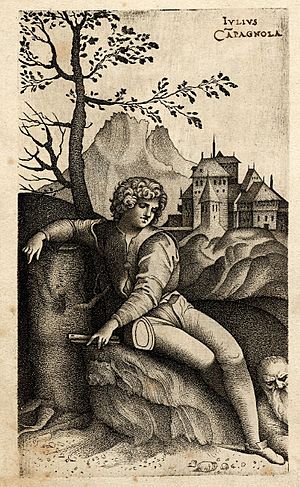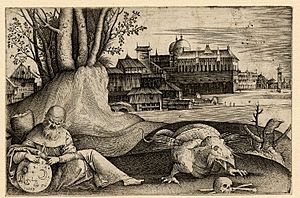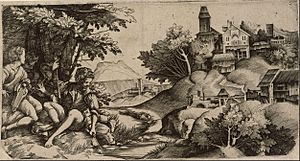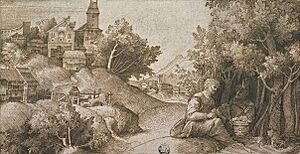Giulio Campagnola facts for kids
Giulio Campagnola (born around 1482, died around 1515) was a talented Italian engraver and painter. He is famous for his rare prints, which brought the rich style of Venetian Renaissance paintings by artists like Giorgione and Titian into the world of engraving. Giulio also invented a special method called the stipple technique. This technique uses many tiny dots or dashes to create smooth changes in tone, making engraved pictures look more like paintings. This invention was very important for future printmaking. He was also the adoptive father of another artist, Domenico Campagnola.
Contents
Early Life and Talents
Giulio Campagnola was born in Padua, a city that was part of the republic of Venice. Padua was home to one of Europe's biggest universities at the time. His father, Girolamo, was a writer and possibly an amateur artist.
Many people, including the famous writer Giorgio Vasari, said that Giulio was very gifted in many artistic areas, even as a teenager. When he was fifteen, a relative wrote a letter describing him as a great poet, singer, and lute player. He could also read Latin, Greek, and Hebrew, and was skilled in painting, engraving, and cutting gemstones. This letter was sent to the court in Mantua, hoping to find him a job there. It's not clear if he went to Mantua, but his work shows the influence of Andrea Mantegna, a famous artist from that area.
Moving to Venice
Around 1499, Giulio briefly appeared in records from Ferrara, another important center for printmaking. After that, there are no records until 1507. At this time, someone in Venice recorded lending him a painting and three copper plates for engraving. Most experts believe he was living in Venice by then.
His engraving called The Astrologer is dated 1509. The last record of him is from 1515, when a printer named Aldus Manutius mentioned him in his will. Manutius asked Giulio to help create new designs for printing type. Giulio also became friends with a poet named Giovanni Aurelio Augurello, who wrote about Giulio's experiments with making blue pigments.
Giulio Campagnola is thought to have died around 1515, probably in Venice. An engraving plate he left unfinished was completed by his adopted son around 1517. He had adopted Domenico Campagnola, who was an orphan, around 1512. Giulio often signed his engravings with his full name and "Antenoreus," a reference to the mythical founder of Padua.
An Independent Artist
Most art experts see Giulio Campagnola as a professional artist who trained in places like Mantua, Ferrara, or Venice. Vasari described him as a painter. Some old records from around 1530 mention small paintings that were believed to be by him, but today, no paintings are definitely known to be his.
There are some drawings that look like his prints, but only a few are truly agreed to be by him. Many historians believe that Giulio was an independent artist. This means he not only created the designs for his prints but also did the engraving work himself. He was not just someone who technically helped a greater artist.
His Unique Engravings
The order of Giulio's works is mostly based on how his style changed, especially around his 1509 engraving, The Astrologer. His early works show a strong influence from the German artist Albrecht Dürer. He even copied one of Dürer's engravings directly and used some of Dürer's landscape ideas. He also included a portrait of Dürer in his Marriage of the Virgin Mary.
The next group of engravings, including The Astrologer, perfectly capture the feeling of Venetian paintings from the early 1500s. These are his most famous works, and they introduce his special stipple technique.
What is Stipple Technique?
Stippling means making an engraving using tiny dots or small flicks of the engraving tool, called a burin, instead of the usual lines. Campagnola could show different shades and tones by changing how many dots he used and how close they were. This was different from the common method of using lines that cross each other (hatching and cross-hatching).
His engravings often combine both lines and stipple work. For example, some of his prints, like The Old Shepherd, The Young Shepherd, and The Astrologer, first appeared with only line work. Later, he reworked the plates, adding stipple to them. His final prints are almost entirely made with dots, except for the main outlines.
Images for kids
-
Ganymede carried off
See also
 In Spanish: Giulio Campagnola para niños
In Spanish: Giulio Campagnola para niños










